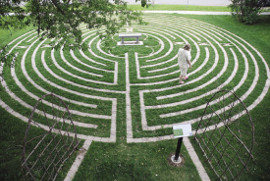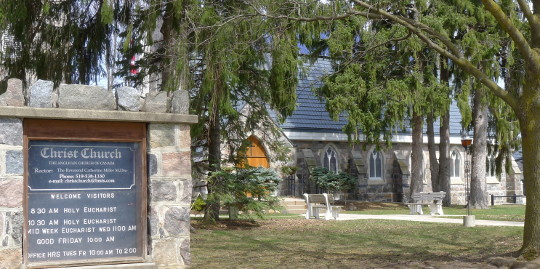Elaine Burns
Christ Church Anglican on Boucher Street is hoping to construct a labyrinth on its front lawn.
“We would like this to be a community project to be used by many,” Cathy Miller, Parish Priest of Christ Church told The Independent.
A labyrinth is an ancient symbol that relates to wholeness. It combines the imagery of the circle and the spiral into a meandering but purposeful path. The labyrinth represents a journey to one’s centre and back again out into the world. Labyrinths have long been used as meditation and prayer tools.
A wide variety of cultures have used labyrinths for at least 3,500 years. Evidence of ancient labyrinths exists in Crete, Egypt, Italy, Scandinavia, and North America. Ancient labyrinths had what is usually called the ‘classical’ design of seven rings, or circuits. They were decidedly pagan in function: many labyrinths were dedicated to a goddess and used in ritualistic dances. The Hopi Indians saw the labyrinth as a symbol of Mother Earth, and the hundreds of stone labyrinths along the Scandinavian shoreline were used as magic traps for trolls and evil winds to ensure safe fishing.
Prayer Labyrinths
Labyrinths have on various occasions been used in Christian tradition as a part of worship. The earliest known example is from a fourth-century pavement at the Basilica of St. Reparatus, at Orleansville, Algeria, though it is unclear how it might have been used in worship.
In medieval times, labyrinths began to appear on church walls and floors around 1000 C.E. The most famous medieval labyrinth, with great influence on later practice, was created in Chartres Cathedral in France. The purpose of the labyrinths is not clear, though there are surviving descriptions of French clerics performing a ritual Easter dance along the path on Easter Sunday. Some books (guidebooks in particular) suggest that mazes on cathedral floors originated in the medieval period as alternatives to pilgrimage to the Holy Land, but the earliest attested use of the phrase “chemin de Jerusalem” (path to Jerusalem) dates to the late 18th century, when it was used to describe mazes at Reims and Saint-Omer. The accompanying ritual, depicted in Romantic illustrations as involving pilgrims following the maze on their knees while praying, may have been practised at Chartres during the 17th century.
 The use of labyrinths has recently been revived in some contexts of Christian worship. Many churches in Europe and North America have constructed permanent, typically unicursal, labyrinths, or employ temporary ones (e.g. painted on canvas or outlined with candles). Some Christians disapprove of labyrinths, considering them pagan practices, or ‘new age’ fads.
The use of labyrinths has recently been revived in some contexts of Christian worship. Many churches in Europe and North America have constructed permanent, typically unicursal, labyrinths, or employ temporary ones (e.g. painted on canvas or outlined with candles). Some Christians disapprove of labyrinths, considering them pagan practices, or ‘new age’ fads.
A labyrinth is a path which leads, via a circular route, to the centre of an intricate design and back out again. A labyrinth’s route is unicursal; that is, it has only a single path. Unlike a maze, a labyrinth is designed for ease of navigation, and it is impossible to get lost within one.
In the Middle Ages, the Catholic church adapted the labyrinth for its own purposes within its cathedrals. Within Catholicism, the labyrinth could symbolize several things: the hard and winding road to God, a mystical ascension to salvation and enlightenment, or even a pilgrimage to Jerusalem for those who could not make the actual journey.
A prayer labyrinth is a labyrinth used to facilitate prayer, meditation, spiritual transformation, and/or global unity. The most famous prayer labyrinths today include an ancient one in the cathedral of Chartres, France, another in the cathedral of Duomo di Siena, Tuscany; and two maintained by Grace Cathedral, an Episcopal church in San Francisco. While prayer labyrinths have been used in Catholic cathedrals for centuries, the past decade has seen resurgence in their popularity, especially within the Emergent Church and among New Age groups and neo-pagans.
Pros and Cons
Proponents of prayer labyrinths speak of using the labyrinth to become enlightened, realigned with the universe, and increasingly empowered to know one’s self and to accomplish the work of the soul.
The concerns of those against the use of prayer labyrinths fall into three categories:
-
The labyrinth has no biblical prototype or pattern as a way to approach God.
-
The labyrinth as used today is often advocated as a way to have a spiritual experience with God. However, the Bible says to “walk by faith, not by sight” (2 Cor. 5.7), and not by seeking experiences.
-
God is not obligated to provide spiritual experiences simply because one tries to initiate or expect them. One may be reconciled with God through faith, and, through a daily walk in Bible reading, prayer, and worship, a relationship with God may grow.
However, both humans and the Church have used various techniques to commune with God, such as climbing the 39 steps found in many churches on one’s knees, the stations of the cross, prayer using the rosary, or even the varied acts of prayer itself may facilitate a personal introspective contemplative communication with God.
How to use a Prayer Labyrinth
Whether using the labyrinth for prayer, meditation, problem solving, or enlightenment, the method is the same.
One walks a labyrinth by stepping into the entrance and putting one foot in front of the other. After travelling through all the paths and windings, the walker comes into the centre, and after a time there, the walker returns out, covering the same path out as in. Labyrinth walks are sometimes referred to as ‘body prayer’, or walking meditation.
The entrance can be a place to stop, reflect, pray, or begin the intention for the spiritual walk. The walk around the design to the centre can be a ‘letting go’ – a quieting of thoughts, worries, lists of tasks to do, a letting go and the experience of being present in one’s body. The centre rosette is a place of prayer/meditation – a ‘letting in’ of God’s guidance, the divine into one’s life. When ready, the walk out, ‘letting out’, takes one back into everyday life, empowered by spirit to transform lives and actions.
In many ways, we see the labyrinth as a call to action, a transformation spiritual tool for people. It can aid healing, help in releasing grief (people often shed tears during the “letting go”), help guide through troubled times, aid in decision making, illuminate our purpose in life, and act as a tool of celebration and thanks. I have seen it be many things for many people. It is important to recognize it as a spiritual practice, not a magical tool. Its work is our commitment to enter into the sacred spiritual walk, not merely once, but to use it as part of an ongoing spiritual practice. –www.sacredwalk.com
Christ Church is looking for the community’s input and help. If this is something that you feel would benefit Meaford as a community, please contact the church at 519-538-1330, or by email: meafordchristchurch@gmail.com.












